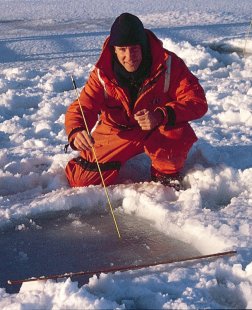| THE UNIVERSITY OF UTAH - Department of Mathematics | |
|
|
Kenneth M. Golden |
|
Research Interests
In many composite materials, the effective behavior depends critically on the connectedness, or percolation properties of a particular phase. For example, sandstones are permeable to water only when there is a high enough volume fraction of pores that they connect and form pathways. Likewise, the electromagnetic properties of a polymer film with conducting particles vary dramatically near the critical volume fraction where the particles begin to form a connected matrix. This critical volume fraction is called the percolation threshold, and near it the effective transport coefficients, such as fluid permeability or electrical permittivity and conductivity, typically display scaling behavior characterized by critical exponents, similar to a phase transition in statistical mechanics. Much of my recent mathematical work has focused on analysis of transport in lattice and continuum percolation models, the connections to statistical mechanics, and the application of these models to porous media, particulate composites used in smart devices and conducting films, and electrorheological fluids.
A particularly interesting example is the case of sea ice, a composite of pure ice with liquid brine and air inclusions. It is permeable to fluid only when the brine volume fraction exceeds about 5%, which corresponds to a critical temperature of around -5 degrees C, allowing transport of brine, nutrients, biomass, and heat through the ice. In the Antarctic, these processes play an important role in air-sea-ice interactions, in the life cycles of sea ice algae, and in remote sensing of the pack. We have been developing percolation models to understand fluid transport in sea ice, and have also made measurements of percolation structures in Antarctic sea ice. Motivated by sea ice remote sensing, we have also been developing (with E. Cherkaev) inverse algorithms for recovering the physical properties of sea ice or other composites via electromagnetic means. This leads to other interesting mathematical problems in electromagnetic scattering, which we have been studying.
In connection with the above areas of research, I have taught graduate courses in the following areas: Mathematics of Materials, Percolation, Statistical Mechanics, Applied Linear Operators and Spectral Methods, Applied Complex Variables and Asymptotic Methods, and Several Complex Variables.
|
 |
||
| [Home] [Class Schedules] [Department Contacts] [College of Science] |
| Department
of Mathematics, 155 South 1400 East, Room 233, Salt Lake City, UT 84103,
1 801 581 6851 © University of Utah Please send comments or questions to webmaster@math.utah.edu -- Web Content Disclaimer -- |